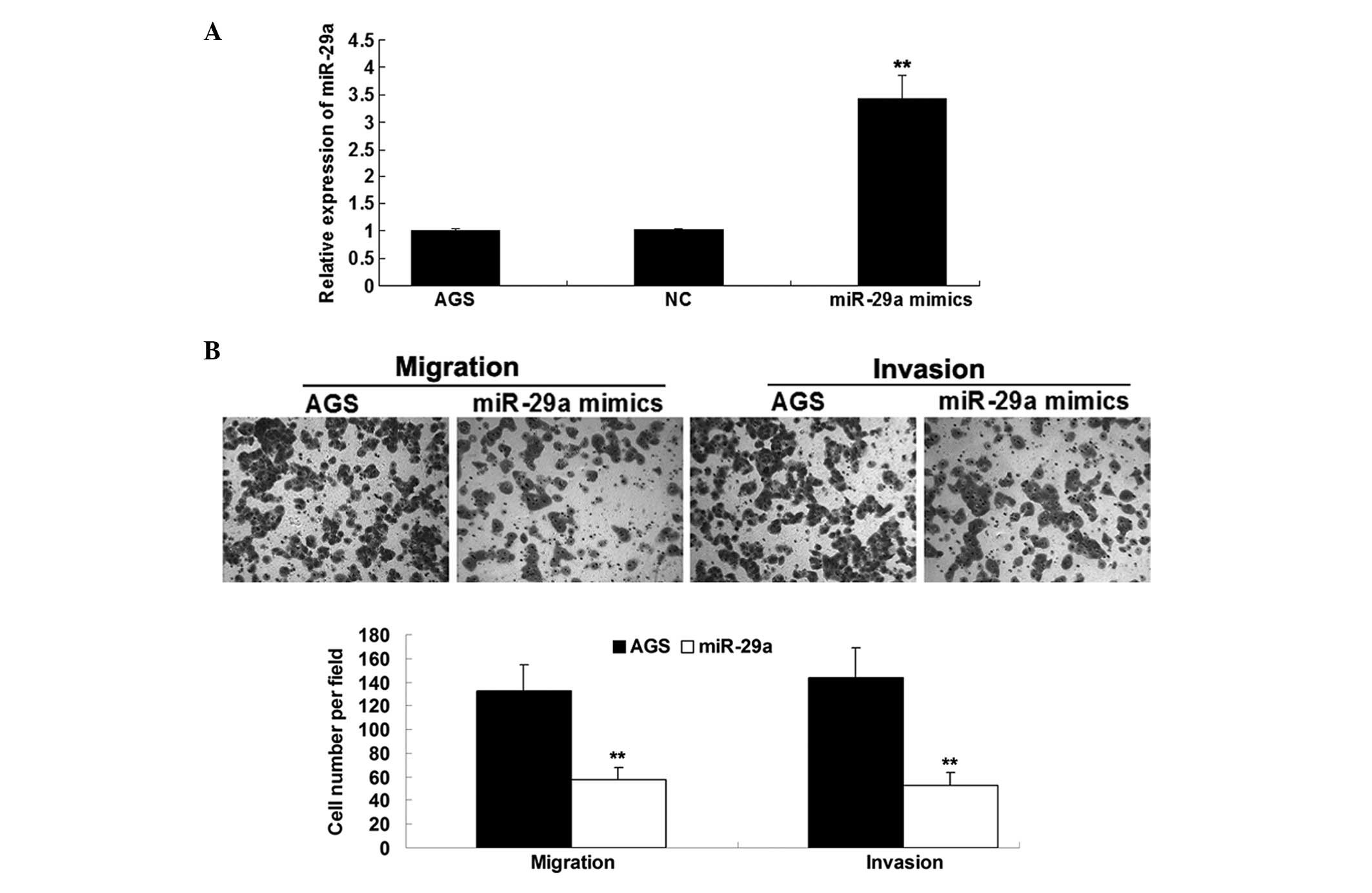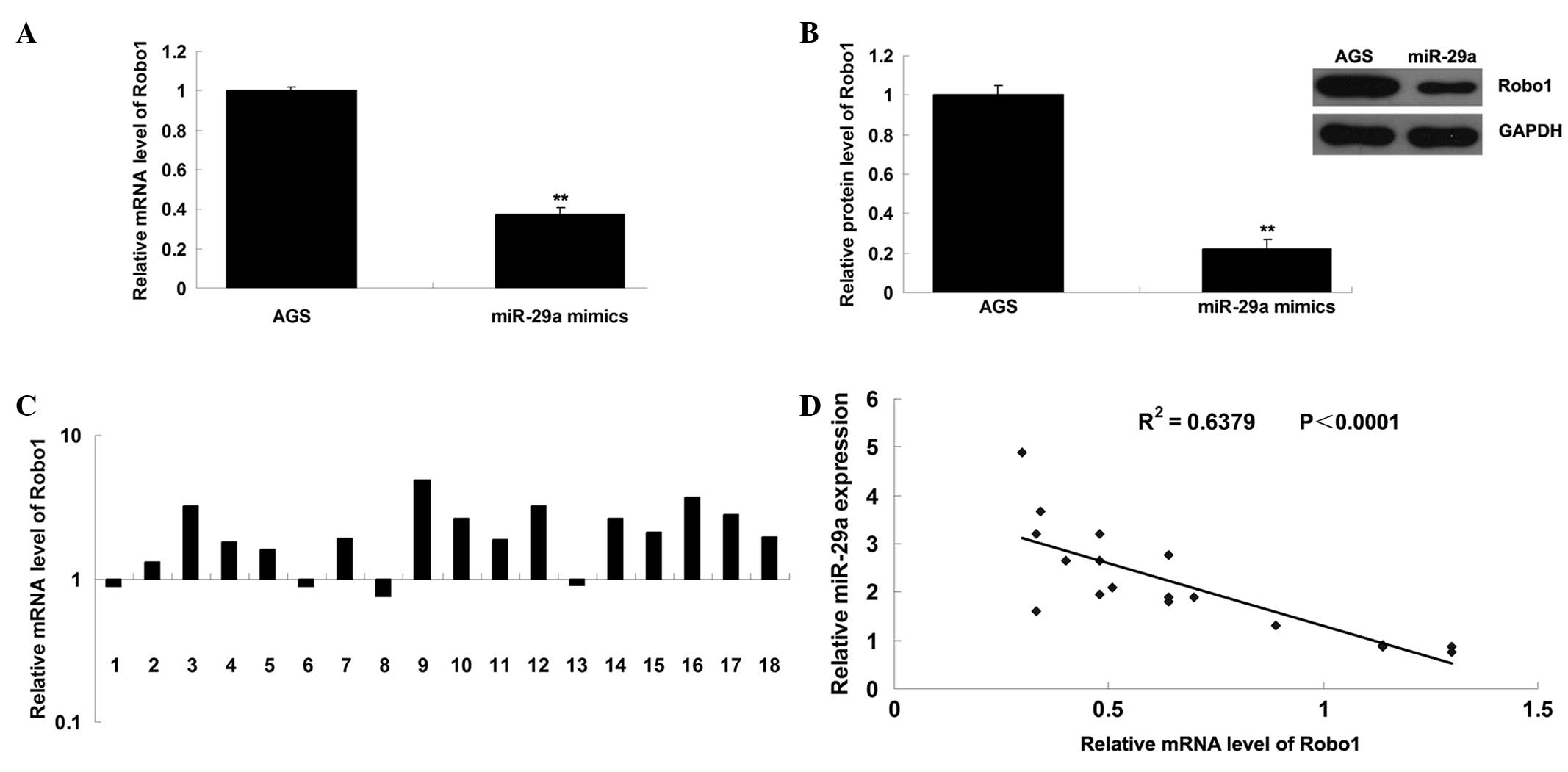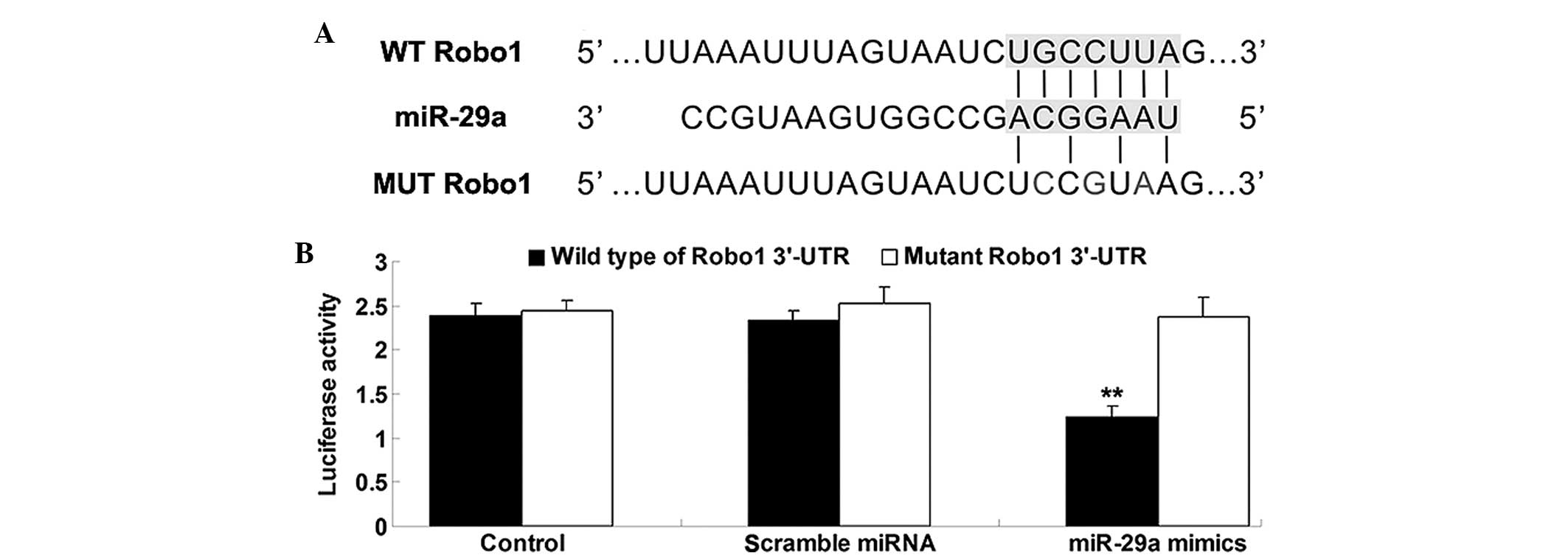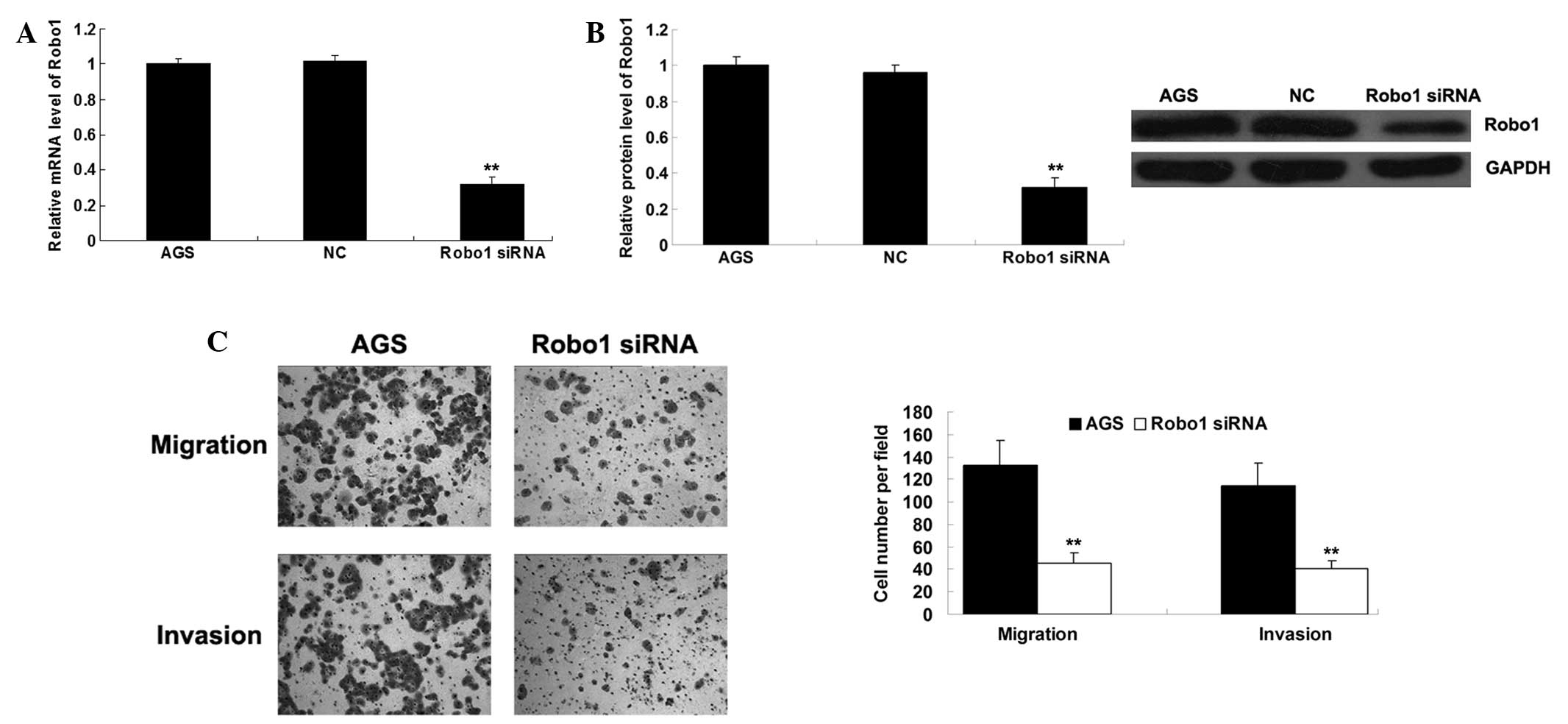|
1
|
Siegel RL, Miller KD and Jemal A: Cancer
statistics, 2015. CA Cancer J Clin. 65:5–29. 2015. View Article : Google Scholar : PubMed/NCBI
|
|
2
|
Ishiguro H, Kimura M and Takeyama H: Role
of microRNAs in gastric cancer. World J Gastroenterol.
20:5694–5699. 2014. View Article : Google Scholar : PubMed/NCBI
|
|
3
|
Piazuelo MB and Correa P: Gastric cancer:
Overview. Colomb Med (Cali). 44:192–201. 2013.
|
|
4
|
Cornide-Petronio ME and Barreiro-Iglesias
A: Role of Slit and Robo proteins in the development of
dopaminergic neurons. Dev Neurosci. 35:285–292. 2013. View Article : Google Scholar : PubMed/NCBI
|
|
5
|
Dickinson RE and Duncan WC: The SLIT-ROBO
pathway: A regulator of cell function with implications for the
reproductive system. Reproduction. 139:697–704. 2010. View Article : Google Scholar : PubMed/NCBI
|
|
6
|
Je EM, Gwak M, Oh H, et al: Frameshift
mutations of axon guidance genes ROBO1 and ROBO2 in gastric and
colorectal cancers with microsatellite instability. Pathology.
45:645–650. 2013. View Article : Google Scholar : PubMed/NCBI
|
|
7
|
Tie J, Pan Y, Zhao L, et al: MiR-218
inhibits invasion and metastasis of gastric cancer by targeting the
Robo1 receptor. PLoS Genet. 6:e10008792010. View Article : Google Scholar : PubMed/NCBI
|
|
8
|
Ambros V: The functions of animal
microRNAs. Nature. 431:350–355. 2004. View Article : Google Scholar : PubMed/NCBI
|
|
9
|
Cheung IY, Farazi TA, Ostrovnaya I, et al:
Deep microRNA sequencing reveals downregulation of miR-29a in
neuro-blastoma central nervous system metastasis. Genes Chromosomes
Cancer. 53:803–814. 2014. View Article : Google Scholar : PubMed/NCBI
|
|
10
|
Zhao D, Jiang X, Yao C, et al: Heat shock
protein 47 regulated by miR-29a to enhance glioma tumor growth and
invasion. J Neurooncol. 118:39–47. 2014. View Article : Google Scholar : PubMed/NCBI
|
|
11
|
Chen L, Xiao H, Wang ZH, et al: miR-29a
suppresses growth and invasion of gastric cancer cells in vitro by
targeting VEGF-A. BMB Rep. 47:39–44. 2014. View Article : Google Scholar :
|
|
12
|
Zhong S, Li W, Chen Z, Xu J and Zhao J:
MiR-222 and miR-29a contribute to the drug-resistance of breast
cancer cells. Gene. 531:8–14. 2013. View Article : Google Scholar : PubMed/NCBI
|
|
13
|
Dontula R, Dinasarapu A, Chetty C, et al:
MicroRNA 203 modulates glioma cell migration via Robo1/ERK/MMP-9
Signaling. Genes Cancer. 4:285–296. 2013. View Article : Google Scholar : PubMed/NCBI
|
|
14
|
Fabbri M, Calore F, Paone A, Galli R and
Calin GA: Epigenetic regulation of miRNAs in cancer. Adv Exp Med
Biol. 754:137–148. 2013. View Article : Google Scholar
|
|
15
|
Kapinas K, Kessler CB and Delany AM:
miR-29 suppression of osteonectin in osteoblasts: Regulation during
differentiation and by canonical Wnt signaling. J Cell Biochem.
108:216–224. 2009. View Article : Google Scholar : PubMed/NCBI
|
|
16
|
Wang XH, Hu Z, Klein JD, Zhang L, Fang F
and Mitch WE: Decreased miR-29 suppresses myogenesis in CKD. J Am
Soc Nephrol. 22:2068–2076. 2011. View Article : Google Scholar : PubMed/NCBI
|
|
17
|
Maurer B, Stanczyk J, Jüngel A, et al:
MicroRNA-29, a key regulator of collagen expression in systemic
sclerosis. Arthritis Rheum. 62:1733–1743. 2010. View Article : Google Scholar : PubMed/NCBI
|
|
18
|
Roncarati R, Viviani Anselmi C, Losi MA,
et al: Circulating miR-29a, among other up-regulated microRNAs, is
the only biomarker for both hypertrophy and fibrosis in patients
with hypertrophic cardiomyopathy. J Am Coll Cardiol. 63:920–927.
2014. View Article : Google Scholar
|
|
19
|
Ahluwalia JK, Khan SZ, Soni K, et al:
Human cellular microRNA hsa-miR-29a interferes with viral nef
protein expression and HIV-1 replication. Retrovirology. 5:1172008.
View Article : Google Scholar : PubMed/NCBI
|
|
20
|
Peng H, Zhong M, Zhao W, et al: Urinary
miR-29 correlates with albuminuria and carotid intima-media
thickness in type 2 diabetes patients. PLoS One. 8:e826072013.
View Article : Google Scholar : PubMed/NCBI
|
|
21
|
Shioya M, Obayashi S, Tabunoki H, et al:
Aberrant microRNA expression in the brains of neurodegenerative
diseases: miR-29a decreased in Alzheimer disease brains targets
neurone navigator 3. Neuropathol Appl Neurobiol. 36:320–330. 2010.
View Article : Google Scholar : PubMed/NCBI
|
|
22
|
Cui Y, Su WY, Xing J, et al: MiR-29a
inhibits cell proliferation and induces cell cycle arrest through
the downregulation of p42.3 in human gastric cancer. PLoS One.
6:e258722011. View Article : Google Scholar : PubMed/NCBI
|
|
23
|
Fukui H, Zhang X, Sun C, et al: IL-22
produced by cancer-associated fibroblasts promotes gastric cancer
cell invasion via STAT3 and ERK signaling. Br J Cancer.
111:763–771. 2014. View Article : Google Scholar : PubMed/NCBI
|
|
24
|
Do MT, Na M, Kim HG, et al: Ilimaquinone
induces death receptor expression and sensitizes human colon cancer
cells to TRAIL-induced apoptosis through activation of ROS-ERK/p38
MAPK-CHOP signaling pathways. Food Chem Toxicol. 71:51–59. 2014.
View Article : Google Scholar : PubMed/NCBI
|
|
25
|
Yang Y, Zhao W, Xu QW, Wang XS, Zhang Y
and Zhang J: IQGAP3 promotes EGFR-ERK signaling and the growth and
metastasis of lung cancer cells. PLoS One. 9:e975782014. View Article : Google Scholar : PubMed/NCBI
|
|
26
|
Wu G, Qin XQ, Guo JJ, Li TY and Chen JH:
AKT/ERK activation is associated with gastric cancer cell
resistance to paclitaxel. Int J Clin Exp Pathol. 7:1449–1458.
2014.PubMed/NCBI
|
|
27
|
Guo N, Liu F, Yang L, Huang J, Ding X and
Sun C: Chemokine receptor 7 enhances cell chemotaxis and migration
of metastatic squamous cell carcinoma of head and neck through
activation of matrix metalloproteinase-9. Oncol Rep. 32:794–800.
2014.PubMed/NCBI
|
|
28
|
Pal S, Moulik S, Dutta A and Chatterjee A:
Extracellular matrix protein laminin induces matrix
metalloproteinase-9 in human breast cancer cell line mcf-7. Cancer
Microenviron. 7:71–78. 2014. View Article : Google Scholar : PubMed/NCBI
|
|
29
|
Chen J, Chen LJ, Zhou HC, et al:
Prognostic value of matrix metalloproteinase-9 in gastric cancer: a
meta-analysis. Hepatogastroenterology. 61:518–524. 2014.PubMed/NCBI
|














